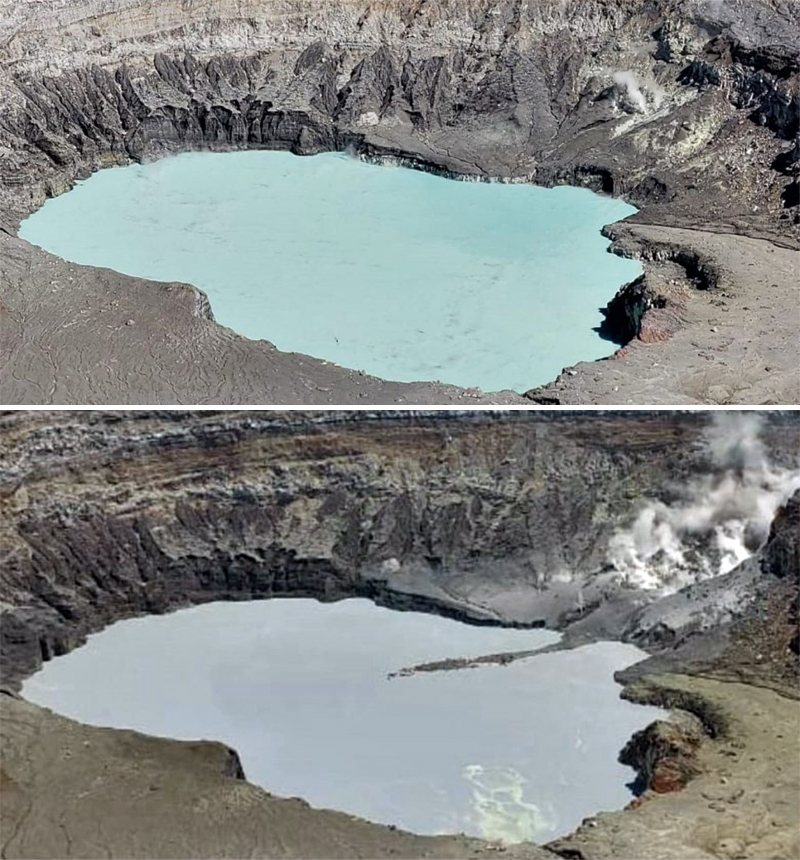Report on Poas (Costa Rica) — June 2022
Bulletin of the Global Volcanism Network, vol. 47, no. 6 (June 2022)
Managing Editor: Edward Venzke.
Research and preparation by Paul Berger.
Poas (Costa Rica) Phreatic explosion on 6 April 2022 generates small plume and deposition in the lake
Please cite this report as:
Global Volcanism Program, 2022. Report on Poas (Costa Rica) (Venzke, E., ed.). Bulletin of the Global Volcanism Network, 47:6. Smithsonian Institution. https://doi.org/10.5479/si.GVP.BGVN202206-345040
Poas
Costa Rica
10.2°N, 84.233°W; summit elev. 2697 m
All times are local (unless otherwise noted)
Activity at Poás is characterized by frequent geyser-like phreatic explosions and weak gas-and-ash-emissions, with an intermittent hot acidic lake in the summit crater. A series of phreatic explosions during April-September 2019 sometimes caused ashfall in nearby communities, and incandescence was sometimes observed at night (BGVN 44:10). The volcano is monitored by the Observatorio Vulcanologico Sismologica de Costa Rica-Universidad Nacional (OVSICORI-UNA). This report summarizes activity from October 2019 through April 2022, based on OVSICORI-UNA reports.
Seismic activity was low during October 2019-March 2022, and no deformation was recorded. The level of the acidic lake remained high, with levels slowly rising between October 2019 and December 2021, but more stable during January-April 2022. The annual bulletin for 2020 indicated that the lake temperature ranged from 43 to 55°C, with pH values between -0.2 and 0.3. Several reports during 2022 indicated that lake temperatures ranged from 35 to 41°C, with pH values between 0.18 and 0.37. Low-temperature fumaroles remained active within the lake and on terraces in the E and NE areas of the active crater. The main fumarole on the NE wall of the crater, named “Fumarola Naranja” (Orange Fumarole), produced strong degassing sounds. According to the 18 March 2022 report, seismicity was at an intermediate level with around 100 events per day (compared to 50 when low or 200 when high), with LP earthquakes.
OVSICORI-UNA reported that at 0242 on 6 April 2022 a phreatic explosion lasting three minutes was detected at Fumarola Naranja, generating a plume that rose 500 m above the crater. The event caused a small landslide that modified the vent. Some of the material from the landslide was deposited in a narrow strip extending about 140 m into the lake. Stirred sediment was visibly moving in convection cells, turning the lake water from a pale green to a uniform milky gray color (figure 131). The fumarolic vents at the E part of the crater and the underwater vent in the S part of the lake continued vigorous activity at least through 19 April.
On 17 April a gas monitoring station in Coronado measured an increased concentration of sulfur dioxide aerosols, between 8.5 and 17.6 micrograms of gas per cubic meter of ambient air, and some residents reported respiratory discomfort such as sneezing, coughing, and shortness of breath. OVSICORI-UNA’s 29 April bulletin indicated that, subsequent to the 6 April event, several new landslides and small hydrothermal explosions occurred in the vertical wall that had collapsed during the 6 April event. Seismic activity and gas ratios remained stable.
Geological Summary. The broad vegetated edifice of Poás, one of the most active volcanoes of Costa Rica, contains three craters along a N-S line. The frequently visited multi-hued summit crater lakes of the basaltic-to-dacitic volcano are easily accessible by vehicle from the nearby capital city of San José. A N-S-trending fissure cutting the complex stratovolcano extends to the lower N flank, where it has produced the Congo stratovolcano and several lake-filled maars. The southernmost of the two summit crater lakes, Botos, last erupted about 7,500 years ago. The more prominent geothermally heated northern lake, Laguna Caliente, is one of the world's most acidic natural lakes, with a pH of near zero. It has been the site of frequent phreatic and phreatomagmatic eruptions since an eruption was reported in 1828. Eruptions often include geyser-like ejections of crater-lake water.
Information Contacts: Observatorio Vulcanologico Sismologica de Costa Rica-Universidad Nacional (OVSICORI-UNA), Apartado 86-3000, Heredia, Costa Rica (URL: http://www.ovsicori.una.ac.cr/).


